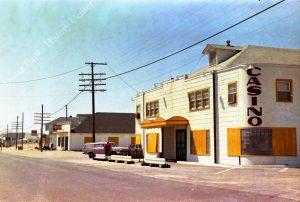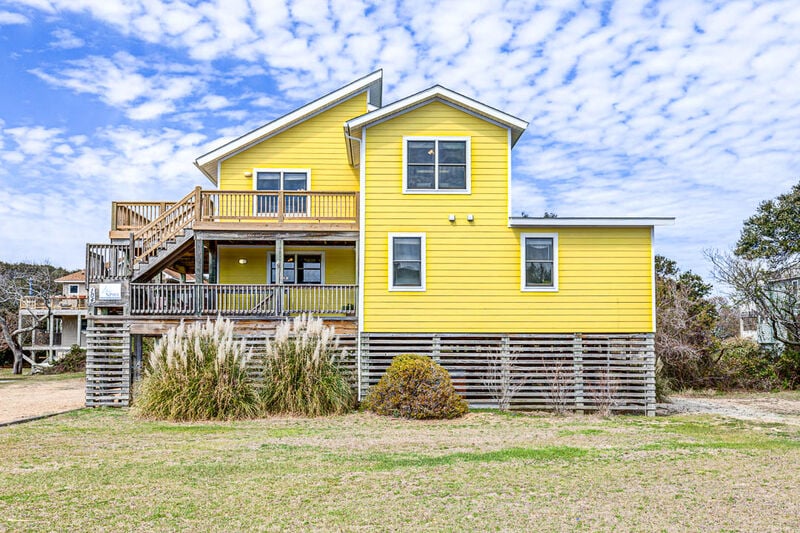There Was Nothing Like the Nags Head Casino

There are Outer Banks places that have become legendary over the years. Perhaps no longer a part of local life, yet the tales linger.If there is one place that would seem to fit that description it is the Nags Head Casino.There is nothing left of it now. Kitty Hawk Kites and Jockey's Ridge Crossing occupy the space where it once stood. Perhaps it's fitting that a business promoting family fun and the Outer Banks now occupies the site where Ras Wescott once had his business.In it's heyday, the 1940s through the 1960s, there was nothing else quite like the Nags Head Casino. Downstairs it was all about families. There was a bowling alley, an arcade, candy, soda and snacks.But upstairs, that's where the legend of Nags Head Casino was created. The floor was buffed to a high sheen, often by Ras himself, and no one...no one... wore shoes when dancing. Or on the second floor. And the music, that's why people kept coming back.The biggest names in jazz, swing, pop and rock 'n' roll came to the Outer Banks; their names reading like a who's who of the their time.Artie Shaw, one of the finest clarinetists of the swing era played the Casino. Fats Domino was there, Count Basie and his Barons of Rhythm made the trip. In the 1960s Bill Deal and the Rhondels came a number of times.On the cusp of fame, Gene Vincent and his Blue Caps played to the Casino in June of 1956. Largely forgotten now, Vincent was a pioneer in rockabilly and rock 'n' roll.Perhaps the biggest name to grace the Casino's stage was Satchmo—Louis Armstrong, on July 12, 1958.The Casino began life as a dormitory housing workers for the Wright Brother MemorialIt took a full year to build the Monument. Construction began in the fall of 1931 and was completed in November of the following year. The 60' constructed from North Carolina granite required skilled stonemasons and the workers needed a place to stay.When the workers left, the building became a dormitory for Depression era WPA (Works Progress Administration) workers who were creating a dune line along the Outer Banks.By 1937 the building stood vacant, and local businessman Ras Wescott saw an opportunity and bought the property.It was at first a soda shop and snack bar, but then Ras added duckpin bowling and an arcade and the following year, 1938, the upstairs became a dance hall.Booking mostly regional acts at first, the popularity of the Casino expanded, but what seems to have really sparked its growth was WWII.What is now Dare County Airport was used for flight training by the Navy and submarine patrols. Coupled with the explosive growth of servicemen at Hampton Roads and a slightly improved transportation system, the Casino became a popular night spot.That popularity came with a price. Local residents who were around at the time recall tensions between servicemen and locals. There is evidence of that.The July 21, 1944 edition of the Dare County Times, the predecessor to the Coastland Times, reported, "The entire court of Judge Baum...was taken up Tuesday of this week with cases arising out of drunkenness, nearly all of them at the Nags Head Casino where drunks are wont to congregate."Included in that report is a "young Colington man jumped up and without provocation, hit Chief Officer Blackman of the Naval Shore Patrol..."Wescott, though, took pride in creating what he considered a wholesome place of recreation. The downstairs was very family oriented, and children were not permitted upstairs.There were bouncers, and when needed, Ras would blow a whistle he had around his neck. Legend has it that when things got tense, patrons would leap out of the second floor windows to the sandy ground below rather than face the bouncers. There are no reports of anyone getting injured jumping to safety.When there was real trouble, though, Donnie Twyne would have been called. Twyne, the first Chief of Police for Nags Head, began his career in law enforcement as a Dare County Deputy. Before he was a policeman, Donnie was a boxer, and as a number of the Casino's more rowdy customers discovered, he backed down to no one.Ras experimented with different ways to bring people to his business. For a while, in the 1950s he sponsored weekly boxing matches.For the most part though, anyone going to the Casino had a good time—that is the overwhelming memory of everyone who recalls being there. That and the floor.It's unclear why Ras began waxing and buffing the dance floor, but he did and shoes were absolutely prohibited. There was even a place to check shoes, much like a coat check.By all accounts, Ras loved swing music and dance music, but as musical tastes changed so did the groups he needed to book. He brought some good groups to the Outer Banks in the 60s, but not the big names he had managed to book a decade earlier.The 1962 Ash Wednesday Storm damaged the building and it took weeks to repair—lost time for Wescott who always opened in March.By the end of the decade, attendance was declining. Wescott, his health declining, sold the building as the decade of the 70s began. Soon after he sold the building, a storm damaged the roof and the building was demolished to make way for the new Kitty Hawk Kites Store and Jockey's Ridge Crossing.
 There are Outer Banks places that have become legendary over the years. Perhaps no longer a part of local life, yet the tales linger.If there is one place that would seem to fit that description it is the Nags Head Casino.There is nothing left of it now. Kitty Hawk Kites and Jockey's Ridge Crossing occupy the space where it once stood. Perhaps it's fitting that a business promoting family fun and the Outer Banks now occupies the site where Ras Wescott once had his business.In it's heyday, the 1940s through the 1960s, there was nothing else quite like the Nags Head Casino. Downstairs it was all about families. There was a bowling alley, an arcade, candy, soda and snacks.But upstairs, that's where the legend of Nags Head Casino was created. The floor was buffed to a high sheen, often by Ras himself, and no one...no one... wore shoes when dancing. Or on the second floor. And the music, that's why people kept coming back.The biggest names in jazz, swing, pop and rock 'n' roll came to the Outer Banks; their names reading like a who's who of the their time.Artie Shaw, one of the finest clarinetists of the swing era played the Casino. Fats Domino was there, Count Basie and his Barons of Rhythm made the trip. In the 1960s Bill Deal and the Rhondels came a number of times.On the cusp of fame, Gene Vincent and his Blue Caps played to the Casino in June of 1956. Largely forgotten now, Vincent was a pioneer in rockabilly and rock 'n' roll.Perhaps the biggest name to grace the Casino's stage was Satchmo—Louis Armstrong, on July 12, 1958.The Casino began life as a dormitory housing workers for the Wright Brother MemorialIt took a full year to build the Monument. Construction began in the fall of 1931 and was completed in November of the following year. The 60' constructed from North Carolina granite required skilled stonemasons and the workers needed a place to stay.When the workers left, the building became a dormitory for Depression era WPA (Works Progress Administration) workers who were creating a dune line along the Outer Banks.By 1937 the building stood vacant, and local businessman Ras Wescott saw an opportunity and bought the property.It was at first a soda shop and snack bar, but then Ras added duckpin bowling and an arcade and the following year, 1938, the upstairs became a dance hall.Booking mostly regional acts at first, the popularity of the Casino expanded, but what seems to have really sparked its growth was WWII.What is now Dare County Airport was used for flight training by the Navy and submarine patrols. Coupled with the explosive growth of servicemen at Hampton Roads and a slightly improved transportation system, the Casino became a popular night spot.That popularity came with a price. Local residents who were around at the time recall tensions between servicemen and locals. There is evidence of that.The July 21, 1944 edition of the Dare County Times, the predecessor to the Coastland Times, reported, "The entire court of Judge Baum...was taken up Tuesday of this week with cases arising out of drunkenness, nearly all of them at the Nags Head Casino where drunks are wont to congregate."Included in that report is a "young Colington man jumped up and without provocation, hit Chief Officer Blackman of the Naval Shore Patrol..."Wescott, though, took pride in creating what he considered a wholesome place of recreation. The downstairs was very family oriented, and children were not permitted upstairs.There were bouncers, and when needed, Ras would blow a whistle he had around his neck. Legend has it that when things got tense, patrons would leap out of the second floor windows to the sandy ground below rather than face the bouncers. There are no reports of anyone getting injured jumping to safety.When there was real trouble, though, Donnie Twyne would have been called. Twyne, the first Chief of Police for Nags Head, began his career in law enforcement as a Dare County Deputy. Before he was a policeman, Donnie was a boxer, and as a number of the Casino's more rowdy customers discovered, he backed down to no one.Ras experimented with different ways to bring people to his business. For a while, in the 1950s he sponsored weekly boxing matches.For the most part though, anyone going to the Casino had a good time—that is the overwhelming memory of everyone who recalls being there. That and the floor.It's unclear why Ras began waxing and buffing the dance floor, but he did and shoes were absolutely prohibited. There was even a place to check shoes, much like a coat check.By all accounts, Ras loved swing music and dance music, but as musical tastes changed so did the groups he needed to book. He brought some good groups to the Outer Banks in the 60s, but not the big names he had managed to book a decade earlier.The 1962 Ash Wednesday Storm damaged the building and it took weeks to repair—lost time for Wescott who always opened in March.By the end of the decade, attendance was declining. Wescott, his health declining, sold the building as the decade of the 70s began. Soon after he sold the building, a storm damaged the roof and the building was demolished to make way for the new Kitty Hawk Kites Store and Jockey's Ridge Crossing.
There are Outer Banks places that have become legendary over the years. Perhaps no longer a part of local life, yet the tales linger.If there is one place that would seem to fit that description it is the Nags Head Casino.There is nothing left of it now. Kitty Hawk Kites and Jockey's Ridge Crossing occupy the space where it once stood. Perhaps it's fitting that a business promoting family fun and the Outer Banks now occupies the site where Ras Wescott once had his business.In it's heyday, the 1940s through the 1960s, there was nothing else quite like the Nags Head Casino. Downstairs it was all about families. There was a bowling alley, an arcade, candy, soda and snacks.But upstairs, that's where the legend of Nags Head Casino was created. The floor was buffed to a high sheen, often by Ras himself, and no one...no one... wore shoes when dancing. Or on the second floor. And the music, that's why people kept coming back.The biggest names in jazz, swing, pop and rock 'n' roll came to the Outer Banks; their names reading like a who's who of the their time.Artie Shaw, one of the finest clarinetists of the swing era played the Casino. Fats Domino was there, Count Basie and his Barons of Rhythm made the trip. In the 1960s Bill Deal and the Rhondels came a number of times.On the cusp of fame, Gene Vincent and his Blue Caps played to the Casino in June of 1956. Largely forgotten now, Vincent was a pioneer in rockabilly and rock 'n' roll.Perhaps the biggest name to grace the Casino's stage was Satchmo—Louis Armstrong, on July 12, 1958.The Casino began life as a dormitory housing workers for the Wright Brother MemorialIt took a full year to build the Monument. Construction began in the fall of 1931 and was completed in November of the following year. The 60' constructed from North Carolina granite required skilled stonemasons and the workers needed a place to stay.When the workers left, the building became a dormitory for Depression era WPA (Works Progress Administration) workers who were creating a dune line along the Outer Banks.By 1937 the building stood vacant, and local businessman Ras Wescott saw an opportunity and bought the property.It was at first a soda shop and snack bar, but then Ras added duckpin bowling and an arcade and the following year, 1938, the upstairs became a dance hall.Booking mostly regional acts at first, the popularity of the Casino expanded, but what seems to have really sparked its growth was WWII.What is now Dare County Airport was used for flight training by the Navy and submarine patrols. Coupled with the explosive growth of servicemen at Hampton Roads and a slightly improved transportation system, the Casino became a popular night spot.That popularity came with a price. Local residents who were around at the time recall tensions between servicemen and locals. There is evidence of that.The July 21, 1944 edition of the Dare County Times, the predecessor to the Coastland Times, reported, "The entire court of Judge Baum...was taken up Tuesday of this week with cases arising out of drunkenness, nearly all of them at the Nags Head Casino where drunks are wont to congregate."Included in that report is a "young Colington man jumped up and without provocation, hit Chief Officer Blackman of the Naval Shore Patrol..."Wescott, though, took pride in creating what he considered a wholesome place of recreation. The downstairs was very family oriented, and children were not permitted upstairs.There were bouncers, and when needed, Ras would blow a whistle he had around his neck. Legend has it that when things got tense, patrons would leap out of the second floor windows to the sandy ground below rather than face the bouncers. There are no reports of anyone getting injured jumping to safety.When there was real trouble, though, Donnie Twyne would have been called. Twyne, the first Chief of Police for Nags Head, began his career in law enforcement as a Dare County Deputy. Before he was a policeman, Donnie was a boxer, and as a number of the Casino's more rowdy customers discovered, he backed down to no one.Ras experimented with different ways to bring people to his business. For a while, in the 1950s he sponsored weekly boxing matches.For the most part though, anyone going to the Casino had a good time—that is the overwhelming memory of everyone who recalls being there. That and the floor.It's unclear why Ras began waxing and buffing the dance floor, but he did and shoes were absolutely prohibited. There was even a place to check shoes, much like a coat check.By all accounts, Ras loved swing music and dance music, but as musical tastes changed so did the groups he needed to book. He brought some good groups to the Outer Banks in the 60s, but not the big names he had managed to book a decade earlier.The 1962 Ash Wednesday Storm damaged the building and it took weeks to repair—lost time for Wescott who always opened in March.By the end of the decade, attendance was declining. Wescott, his health declining, sold the building as the decade of the 70s began. Soon after he sold the building, a storm damaged the roof and the building was demolished to make way for the new Kitty Hawk Kites Store and Jockey's Ridge Crossing.








